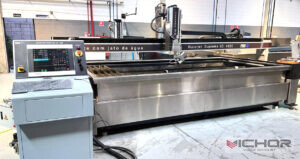
5 Essential Factors to Consider When Investing in a Small Water Jet Cutter
In today’s competitive manufacturing and fabrication landscape, precision and versatility are paramount. Whether you’re a small workshop owner, an artist, or an engineer, the need for efficient cutting tools that handle diverse materials without compromising quality is ever-growing. Enter the small water jet cutter—a compact yet powerful machine that leverages high-pressure water, often mixed with abrasives, to slice through materials with remarkable accuracy. Unlike traditional methods like laser or plasma cutting, water jet technology offers a cold-cutting process, eliminating heat-affected zones and making it ideal for delicate or heat-sensitive materials. This article delves into the world of small water jet cutter systems, exploring their benefits, applications, and key considerations for selection. We’ll also highlight how brands like VICHOR are shaping the international water jet cutting industry with innovative solutions. By the end, you’ll have a clear understanding of why investing in a small water jet cutter could revolutionize your projects, along with practical advice to guide your purchase.
What is a Small Water Jet Cutter?
A small water jet cutter is a scaled-down version of industrial water jet systems, designed for spaces like workshops, labs, or small-scale production facilities. It operates by pressurizing water to extreme levels—often up to 60,000 PSI or more—and directing it through a tiny nozzle to create a focused stream. When cutting harder materials like metals or ceramics, an abrasive such as garnet is added to the stream, enhancing its cutting power. This process, known as abrasive water jet cutting, allows the small water jet cutter to handle a wide array of materials, including steel, glass, titanium, and composites, with precision tolerances as fine as 0.1 mm. The compact design makes it accessible for businesses that lack the space for larger machinery, without sacrificing the core advantages of water jet technology, such as minimal material waste and no thermal distortion. For instance, VICHOR’s range of small water jet cutter models integrates user-friendly controls and energy-efficient pumps, catering to startups and educational institutions seeking reliable performance.
Key Advantages of Using a Small Water Jet Cutter
The appeal of a small water jet cutter lies in its multifaceted benefits. First and foremost, it provides exceptional versatility. Unlike specialized cutters, it can effortlessly switch between materials—from cutting intricate designs in stone for art projects to shaping aerospace components—all without tool changes. This flexibility reduces downtime and increases productivity. Additionally, the cold-cutting nature of water jets prevents material hardening or warping, which is crucial for metals like aluminum or plastics that are sensitive to heat. Another significant advantage is environmental friendliness; water jet cutting produces no hazardous fumes or dust, aligning with green manufacturing trends. Cost-effectiveness is also a highlight: while initial investment might seem substantial, the small water jet cutter minimizes secondary processing needs, saving on labor and material costs over time. Brands like VICHOR enhance these benefits with features like automated software integration, which streamlines operations for small businesses aiming to scale up.
Common Applications Across Industries
The small water jet cutter finds utility in a surprising range of sectors, demonstrating its adaptability. In the automotive industry, it’s used for prototyping and customizing parts, such as gaskets or brackets, with high precision. Art and design professionals leverage it for creating detailed sculptures, signage, or jewelry from materials like marble or acrylic, where traditional tools might cause cracks or burns. The aerospace and defense sectors rely on small water jet cutter systems for cutting composite materials and alloys, ensuring structural integrity without introducing stress points. Even in medical device manufacturing, these machines produce intricate components from biocompatible materials like titanium, adhering to strict hygiene standards. Moreover, educational institutions use compact water jets for research and training, providing hands-on experience with advanced fabrication techniques. VICHOR, as a leader in the international water jet cutting arena, offers tailored solutions for these applications, emphasizing reliability and support for niche requirements.
How to Choose the Right Small Water Jet Cutter for Your Needs
Selecting the perfect small water jet cutter involves evaluating several factors to match your specific demands. Start by assessing the materials you’ll cut most frequently. For softer materials like foam or rubber, a pure water jet might suffice, but for metals or ceramics, an abrasive small water jet cutter is essential. Next, consider the machine’s size and footprint—measure your workspace to ensure a comfortable fit without obstructing other operations. Power and pressure ratings are critical; higher PSI (pounds per square inch) typically translates to faster cutting speeds and better performance on thick materials. Look for models with adjustable pressure settings to optimize energy use. Software compatibility is another key aspect; user-friendly CNC interfaces can simplify design imports and automation. Don’t overlook maintenance requirements; opt for a small water jet cutter with accessible parts and reliable customer support. For example, VICHOR’s models often include remote diagnostics and training resources, reducing downtime. Finally, budget constraints should guide your decision—balance upfront costs with long-term savings from efficiency and durability.
Understanding the Costs and Investment
When it comes to pricing, a small water jet cutter can range from $20,000 to $100,000 or more, depending on features and brand reputation. Initial costs include the machine itself, installation, and any necessary accessories like abrasive feeders or water purification systems. Operational expenses involve electricity, water consumption, abrasive materials, and routine maintenance—factors that can add up over time. However, the return on investment (ROI) is often favorable due to reduced material waste and higher throughput. Leasing or financing options might make a small water jet cutter more accessible for small businesses. It’s wise to compare quotes from multiple suppliers and consider total cost of ownership rather than just the sticker price. VICHOR, for instance, offers competitive pricing packages with warranty extensions, making their small water jet cutter systems a cost-effective choice for international clients seeking value without compromising on quality.
Technological Insights and Innovations
The technology behind a small water jet cutter has evolved significantly, driven by advancements in pump design, nozzle materials, and control systems. Modern pumps, such as intensifier or direct-drive types, deliver consistent high pressure while improving energy efficiency. Nozzles made from durable materials like sapphire or diamond extend lifespan and maintain cutting accuracy. On the software front, integration with CAD/CAM programs allows for seamless translation of digital designs into cutting paths, enhancing precision for complex shapes. Innovations like 5-axis cutting heads enable bevel cuts and 3D profiling, expanding the capabilities of a small water jet cutter. In the international market, companies like VICHOR invest in R&D to incorporate IoT features for real-time monitoring and predictive maintenance, ensuring their machines stay ahead in performance and reliability. Understanding these technological aspects can help users maximize their small water jet cutter’s potential and adapt to future industry trends.

Why VICHOR Excels in the Water Jet Cutting Market
As a prominent name in the international water jet cutting sector, VICHOR has built a reputation for producing robust and innovative small water jet cutter systems. Their machines are engineered with a focus on user experience, featuring intuitive controls and high-pressure pumps that deliver consistent results. VICHOR emphasizes durability, using corrosion-resistant components to withstand harsh environments, which is crucial for industries like marine or construction. Beyond hardware, they offer comprehensive support, including training, spare parts availability, and global service networks. This commitment to customer success makes VICHOR a trusted partner for businesses adopting small water jet cutter technology. By choosing a brand like VICHOR, users gain access to cutting-edge features that enhance productivity, such as automated abrasive recycling systems and energy-saving modes, ultimately providing a competitive edge in various applications.
In conclusion, a small water jet cutter is more than just a tool—it’s a gateway to enhanced creativity and efficiency in modern fabrication. By considering factors like application needs, costs, and technological features, you can make an informed decision that aligns with your goals. Brands like VICHOR continue to push boundaries in the water jet cutting field, offering solutions that empower small-scale operations to achieve big results. As you explore options, remember that the right small water jet cutter can transform your workflow, delivering precision and versatility that pay dividends for years to come.
Frequently Asked Questions
Q1: What types of materials can a small water jet cutter handle effectively?
A1: A small water jet cutter can efficiently cut a wide variety of materials, including metals like steel and aluminum, composites, glass, stone, ceramics, rubber, and plastics. Its versatility makes it suitable for diverse industries, from manufacturing to art, without causing heat-related damage.
Q2: How does the maintenance for a small water jet cutter compare to other cutting machines?
A2: Maintenance for a small water jet cutter is generally straightforward but requires regular checks on components like pumps, nozzles, and seals to prevent wear. It often involves less downtime than thermal cutters, as there are no lenses or gases to replace frequently. Brands like VICHOR provide detailed maintenance guides and support to simplify upkeep.
Q3: Is a small water jet cutter suitable for beginners or small businesses with limited experience?
A3: Yes, many small water jet cutter models are designed with user-friendly interfaces and software, making them accessible for beginners. With basic training and support from suppliers like VICHOR, small businesses can quickly integrate these machines into their operations to improve precision and productivity.
Q4: What is the typical lifespan of a small water jet cutter, and how can it be extended?
A4: A well-maintained small water jet cutter can last 10–15 years or more. Extending its lifespan involves routine cleaning, using high-quality abrasives, monitoring water quality, and following manufacturer guidelines. Regular servicing from providers like VICHOR can also help identify issues early.
Q5: How does the cost of operating a small water jet cutter break down over time?
A5: Operating costs for a small water jet cutter include expenses for electricity, water, abrasive materials, and occasional part replacements. While abrasive consumption can be a significant factor, efficient models from brands like VICHOR often feature recycling systems to reduce long-term costs, making it a sustainable investment for many applications.
continue reading



